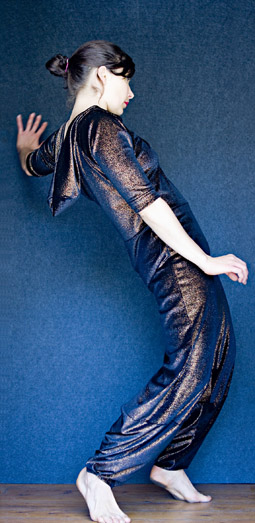 |
Deanne Butterworth, Vianne photo Rohan Young |
In Chaos, Territory, Art (New York: Columbia University Press, 2008), Elizabeth Grosz writes of the frame as a basic element of the artwork. The frame provides an edge. It separates so that we can experience that which it frames. Shelley Lasica’s Vianne institutes many kinds of framing. Physically it is set inside a large, downstairs city theatre space, flanked by laneways on two sides. We can see out onto the laneway. Its fading, crepuscular light establishes the interiority of the room. During the course of the performance, a large light illuminates the lane. Later, another arises inside, shifting the origin of light—fashioning a series of emerging and dying suns. What we see, we see in virtue of these tangible sources. Their emergence and diminution draws attention to the relation between each light source and its zone of illumination. Looking beyond the room (into the laneway) circumscribes the room. It is not the world, rather it is a world within the world.
And within that world is constructed an even smaller world. This small world is a cube made of soft plastic (by Anne-Marie May). Hoisted into position by the dancers, it frames an inner space, another space of action. Some of the dancers traverse that space, others stay inside it for a while. This small world collapses, breathes out, flattens. Spatial boundaries are thus fluid. Like the lighting (Ben Cobham), the physical objects and their manner of framing are subject to change. A liquid-like sculpture is suspended from the ceiling towards the back of the room, flowing into the floor. Later, a related soft, plastic, linear thread is suspended between two dancers. In each case, we are invited to watch the action within, across and according to these shifting frames.
The room itself calls for choices on the part of the audience. Since the action moves across and between large steel poles that support the roof, we have to decide who and what to watch. The action does not entirely dictate these choices, for there is more going on than we can see. Our focus variously engages the shifting points of action, lighting and construction. That movement between structural, shifting elemental qualities, including the roving perceptual field of the audience itself, constitutes an ongoing framing and reframing process. This is permeated by the shifting rhythmic qualities of the music (Milo Kossowski and Morgan McWaters). The music moves imperceptibly between a range of tones and qualities: ambient, insistent, thumping, stellar, epic, abstract. It is evocative but not dominating.
Five dancers march into the space, all dressed in sparkling jumpsuits. One (Deanne Butterworth) stands out, rendered different by the colour of her costume, orange. There is a sociality to this nexus of human interactions, though their meaning is not obvious. Over the course of time, a narrative of sorts unfolds, suggestive of some kind of drama, though remote at the same time, as if its canvas has been painted over, sanded back and bleached (but not emptied) of emotion. Movement phrases are individually executed, alongside the formation of duos and trios. The partnering evokes a range of feelings: tender, aggressive, intimate, depending on who we watch and how they work together. However interpreted, we see dancers move together, push against each other, give weight, circle each other, execute phrase materials, and return to repeat the exercise. A mini-world is created, with boundaries that some respect, and others transgress. Sometimes everyone comes together in a row, shifting weight back and forth, a Greek chorus compared with so much atomic and molecular (inter)action.
If Butterworth is Vianne, she is not the central figure of this work. She orbits and enters the action as a human amongst others. There is no hero here, rather a complex mingling of physical subjectivities in a range of shifting formations. There is a play between the ways the bodies are shaped by their context and the agency of those bodies. The audience is also held accountable for its engagement with the work. The dancers are crisp and clear, responsible and reliable. If I could add my own preference, it would be to make of their own bodies another interiority, to take more time to feel that which occurs within in the context of their moving. The collaborative texture of Vianne suggests that no one person holds the key to its interpretation.There is no bird’s eye view, just the feeling that there is more to be revealed of this intricate composition.
Vianne, choreographer, director Shelley Lasica, dancers, Deanne Butterworth, Timothy Harvey, Jo Lloyd, Bonnie Paskas, Lee Serle, music Milo Kossowski, Morgan McWaters (PEACE OUT!), design Anne-Marie May, costumes Shelley Lasica, Kara Baker (PROJECT), lighting, design consultants Bluebottle/Ben Cobham; fortyfivedownstairs, Melbourne. Dec 3–14, 2008
From RT#89 Feb-March 2009 pg33
For full program and booking information: www.dancemassive.com.au
© Philipa Rothfield; for permission to reproduce apply to [email protected]








 back
back